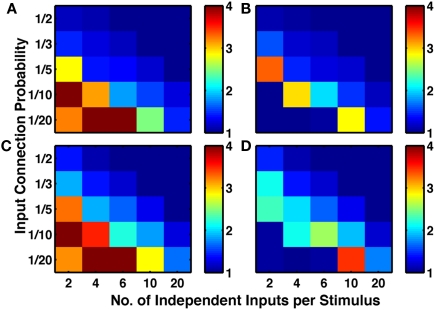Figure 10.
Stronger stimulus specificity produces networks with high numbers of bidirectional connections. If single stimuli are activated, rather than paired stimuli, more selective responses arise, with less need for functional plasticity. Sets of five by five networks with different degrees of sparseness of inputs (y-axis where low input probability reflects high sparseness of inputs) and different degrees of input correlations (x-axis where more input groups per stimulus reflects lower correlations). (A) Network with no functional plasticity, just structural plasticity. (B) Network with triplet-STDP and structural plasticity. (C) Network with LTPi and structural plasticity. (D) Network with triplet-STDP, LTPi, and structural plasticity. While in both cases (A–C) and (B–D) addition of inhibitory plasticity increases the numbers of networks with excess bidirectional connections, for many networks, structural plasticity alone is sufficient to produce excess bidirectional connections (color bar, red = 4 times chance, blue = chance). Networks trained with 400 trials of the single stimulus-response matching task.

